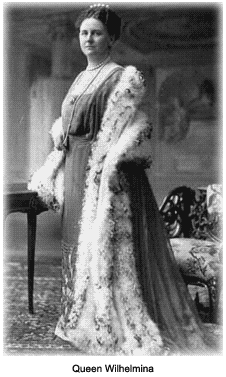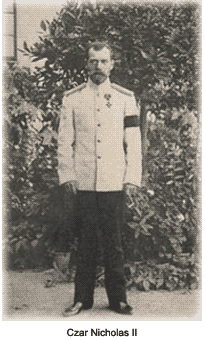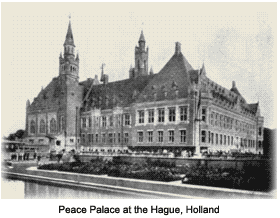The Hague Conferences: Seeking Peace
International interest in promoting peace developed in the late 19th century, prompted by the acrimonious race for empire among the great powers. On a number of occasions, the competing nations had come close to major war as a result of tensions in Africa or the Far East or elsewhere. After gaining possessions from its victory in the Spanish-American War, the United States also became interested in finding ways to avert conflict. During these years, two major international gatherings considered means of promoting peace.

- The First Hague Conference
Summoned in May, 1899 by Czar Nicholas II of Russia and Queen Wilhelmina of the Netherlands, the First Hague Conference was attended by 26 nations, including a distinguished delegation from the United States. The conference was charged with charting a course toward disarmament and placing limitations on the means of conducting warfare. Unfortunately, varying aims of the participating nations made agreement impossible.
One positive achievement did emerge from the gathering, however. Provisions were made for the establishment of the Permanent Court of Arbitration (popularly known as the Hague Tribunal), a body that would render binding decisions on international disputes between cooperating nations. The idea of arbitration was very popular in the United States in the early 20th century and Theodore Roosevelt submitted the first case to the Court (a minor dispute with Mexico). Later, the Venezuelan crisis of 1902 was settled through the auspices of the Court’s arbitrators.

- The Second Hague Conference
In 1907, with 46 nations assembled at The Hague, the United States pushed for the establishment of a world court. The body was to be a type of supreme court that would issues decisions based upon international law and precedent, a markedly different function from the arbitration activities of the Permanent Court. Discussions reached an impasse over the issue of how the judges were to be selected. Naturally enough, every member nation wanted its judges included.
In the absence of agreement on the main topic, the conference experienced some apparent success in adopting resolutions defining the rules of conduct in modern warfare. However, in the months following adjournment, many nations failed to ratify the resolutions and others attached so many reservations that they were sapped of all authority.
 One clear achievement did emerge from the Second Hague Conference. The delegates agreed on the wording of a model arbitration treaty that was to be used by consenting nations. The Hague Tribunal was to settle differences among signatories, except in cases involving sovereignty, vital interests or national honor.
One clear achievement did emerge from the Second Hague Conference. The delegates agreed on the wording of a model arbitration treaty that was to be used by consenting nations. The Hague Tribunal was to settle differences among signatories, except in cases involving sovereignty, vital interests or national honor.
Promotion of peace was a popular topic of international discussion in the early 20th century. ^Andrew Carnegie used his vast financial resources to foster the movement, providing funding for the construction of the Peace Palace at The Hague, the home of the Hague Tribunal. Various secretaries of state, including
John Hay,
Elihu Root and William Jennings Bryan^, devoted much time and energy to negotiating arbitration treaties with other nations.


 One clear achievement did emerge from the Second Hague Conference. The delegates agreed on the wording of a model arbitration treaty that was to be used by consenting nations. The Hague Tribunal was to settle differences among signatories, except in cases involving sovereignty, vital interests or national honor.
One clear achievement did emerge from the Second Hague Conference. The delegates agreed on the wording of a model arbitration treaty that was to be used by consenting nations. The Hague Tribunal was to settle differences among signatories, except in cases involving sovereignty, vital interests or national honor.